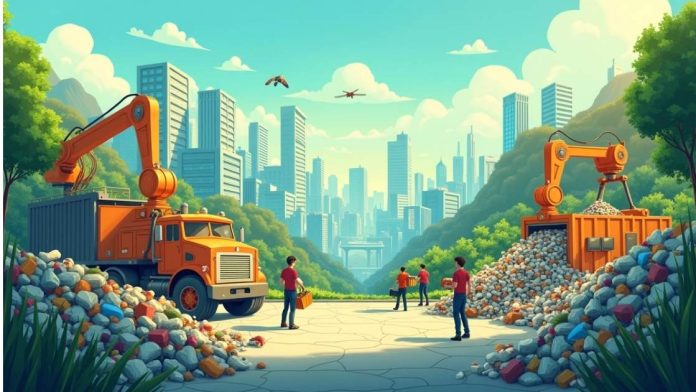Imagine a world where yesterday’s trash becomes tomorrow’s treasure—not just in art and crafts, but at an industrial, game-changing scale. Welcome to the revolutionary world of upcycling technologies, where innovation meets sustainability.
In today’s age of fast fashion, single-use plastics, and consumer convenience, waste has become an unfortunate byproduct of modern life. But here’s the good news: upcycling technologies are stepping in as unsung heroes, transforming discarded materials into high-value products, reducing our ecological footprint, and inspiring a new wave of eco-conscious living.
Let’s dive deep into how these technologies are not only reducing waste but also creating exciting opportunities for innovation and sustainable business.
What is Upcycling, and Why Does It Matter?
You’ve probably seen upcycled jeans turned into trendy bags or pallets turned into rustic furniture. That’s upcycling in its simplest form—giving waste a second life with equal or greater value.
But when we talk about upcycling technologies, we’re referring to advanced processes and systems that use science and engineering to transform materials like plastics, textiles, electronics, and even food waste into something new and useful.
Unlike recycling, which often downgrades the material quality, upcycling enhances or retains the original value—making it a powerful tool in fighting climate change, reducing landfill overflow, and conserving resources.
How Upcycling Technologies Work: The Science Behind the Magic
Let’s break down some key tech-driven methods that are turning waste into wealth:
1. Chemical Upcycling
This technology breaks down plastics and other polymers at the molecular level to rebuild them into more durable or versatile materials. Companies like Carbios are using enzymes to decompose PET plastics into reusable monomers, which can be remade into brand-new plastic bottles.
2. Textile-to-Textile Regeneration
Brands like Worn Again Technologies have pioneered methods to separate blended fibers (like cotton-polyester) and turn them into new yarns. This is a game-changer for the fashion industry, where blended fabrics were previously non-recyclable.
3. E-Waste Upcycling
E-waste (think old smartphones and laptops) is full of valuable metals. Upcycling tech extracts components like gold, silver, and rare earth elements using clean, non-toxic methods. Startups like Urban Mining Company are leading the charge here.
4. Organic Waste to Bioplastics
Innovative biotech firms are now using food waste or agricultural byproducts to create bioplastics. This not only solves the plastic pollution problem but also addresses food waste in a meaningful way.
5. 3D Printing with Recycled Materials
Upcycled plastics and metals are now being fed into 3D printers to create everything from building materials to fashion accessories. It’s cost-effective, creative, and eco-friendly.
Real-World Success Stories to Inspire You
Here are some incredible examples of upcycling technologies already making waves:
-
ByFusion turns unrecyclable plastics into eco-friendly construction blocks called ByBlocks.
-
Renewcell takes discarded cotton clothes and turns them into a new material called Circulose®, which can be used to make new garments.
-
Terracycle has created a global platform that recycles and upcycles nearly anything—from cigarette butts to snack wrappers.
These aren’t just feel-good stories—they’re powerful proof that waste can fuel innovation and profit.
How You Can Support Upcycling in Your Daily Life
Even if you’re not a tech inventor, you can still ride the upcycling wave in practical ways:
✅ Buy from Upcycling Brands
Look for companies that use upcycled materials—like Patagonia, Elvis & Kresse, or Rothy’s. Your dollars are your vote!
✅ Host a Community Swap or Workshop
Encourage neighbors to bring unwanted items for swapping or creative upcycling projects. It’s fun, social, and sustainable.
✅ DIY with Purpose
Instead of tossing that old ladder, turn it into a bookshelf. Old T-shirts? Perfect for reusable shopping bags. Get creative!
✅ Support Local Innovation
Many cities have makerspaces or sustainability hubs focused on material reuse. Join one, volunteer, or donate items.
✅ Educate Others
Share what you learn with friends and family. Start conversations, post about your upcycling wins on social media, or join online forums.
Why Upcycling Tech is a Game-Changer for the Planet
The environmental stats speak volumes:
-
Over 2.12 billion tons of waste are dumped every year.
-
Less than 10% of plastic ever produced has been recycled.
-
Textile waste is expected to hit 148 million tons by 2030.
Upcycling technologies tackle these numbers head-on by:
-
Reducing demand for virgin resources.
-
Lowering carbon emissions.
-
Minimizing toxic waste.
-
Creating circular economies where waste becomes raw material for something new.
It’s no longer about doing less harm. It’s about doing more good.
Frequently Asked Questions (FAQs)
1. What’s the difference between recycling and upcycling?
Recycling usually breaks materials down, often resulting in a lower-quality product. Upcycling, on the other hand, adds value by repurposing materials into something as good—or better—than the original.
2. Is upcycling only for plastic and clothing?
Not at all! Upcycling technologies apply to food waste, electronic waste, construction debris, furniture, and more.
3. Are upcycled products safe and durable?
Absolutely. Many upcycled products meet or exceed safety and durability standards. In some cases, they even outperform traditional counterparts.
4. Can upcycling be profitable?
Yes! Startups and businesses in the upcycling space are tapping into a growing eco-conscious market. Upcycling reduces material costs and can create premium-priced sustainable products.
5. How do I start an upcycling business?
Start small: research a niche (like textiles or plastics), experiment with prototypes, partner with local suppliers, and validate your product idea through markets or online platforms.
Conclusion
Upcycling technologies are more than a trend—they’re a revolution. By transforming waste into opportunity, they challenge us to reimagine our role in the planet’s future. Whether you’re a tech enthusiast, eco-warrior, entrepreneur, or just someone who hates throwing things away, there’s a place for you in this movement.
So, let’s flip the script on waste—one upcycled product at a time.
Have you tried upcycling at home or discovered a brilliant new product made from waste? We’d love to hear from you! Share your favorite upcycling hacks, brands, or success stories in the comments below. Let’s inspire each other to create a cleaner, greener world. 🌿

